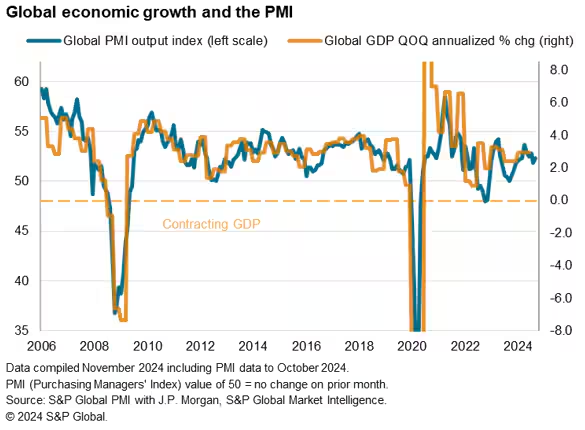As 2024 draws to a close, it is becoming clear that the U.S. equities have led the way for most of the year. The accompanying chart shows the relative returns of equities by major region against the MSCI All-C ountry World Index (ACWI). The U.S. has been the only safe-haven of growth as the economies of other regions sputtered.
This was the year of TINA (There Is No Alternative) for American equities. Can it continue into 2025?
The story of American Exceptionalism
Across the Atlantic, Germany has been beset by manufacturing weakness and falling employment. France, the other major axis of Europe, is mired in a budget crisis as the yield spreads on French OATs blow out.
Asia isn’t faring much better. The Chinese economy continues to sputter. The BoJ is trying to normalize interest rates, but by tightening monetary policy in the face a trend of global easing, it is risking a disorderly unwind of the Yen carry trade. In addition, South Korea is facing a political crisis that’s rattled markets.
As a consequence, the USD is following the path set in 2016 after Trump won the election.
A different kind of cycle
This time, the easing response to excessively tight monetary policy. Inflation, which had spiked in the wake of the COVID pandemic response, is now normalizing. Fed Chair Powell stated last week that the economy is strong and signaled the Fed is likely to slow the pace of easing, “The good news is that we can afford to be a little more cautious as we try to find” the neutral rate. The market interpreted his remarks as the Fed will cut by a quarter-point at the December FOMC meeting and ease on a gentler path in 2025.
Inflation surprises around the world have stabilized, which may be a concern as most inflation measures haven’t fallen to their 2% targets.
Financial markets have responded with a risk-on tone to these conditions. Most global stock markets are at or near either recovery or all-time highs. Yield spreads, with certain exceptions like France, are tight.
A year of transition
- The Gold/S&P 500 is undergoing a multi-year bottom process, which is a signal of a slow shift from disinflation to reflation.
- Similar synchronized bottoming processes can be seen in size (small vs. large caps), value/growth and small-cap value/large-cap growth.
- While equity factor returns such as size and value/growth cycles are evident, gold is still dominant, as shown by the gold/S&P 600 small-cap chart (bottom panel).
I believe 2025 will be a year of transition for global markets: from large caps to small caps, from growth to value and from paper assets to hard assets, and gold in particular. From a contrarian perspective, even the perennially bearish David Rosenberg has thrown in the towel on his bearish stock market call and cited an “AI-induced model shift” as part of his reasoning.
From a global perspective, U.S. equities are richly valued. The equal-weighted S&P 500 trades at a forward P/E of about 20, which isn’t cheap. Any way you look at it, if you exclude the Magnificent Seven or on an equal-weighted basis for the S&P 500, the price-to-book ratio of U.S. stocks is far higher than other developed markets, as measured by MSCI EAFE.
Opportunities are starting to appear in Europe. Historically, spikes in eurozone spreads have been good entry points into European assess. Tactically, it’s probably too early as the French contagion hasn’t spread to the rest of the eurozone. Wait for the panic over the next euro crisis. France is too big to save, which is precisely why the Eurocrat Establishment will save it.
As for Asia, I would prefer to wait for greater clarity on the Chinese growth outlook and how the BoJ normalizes monetary policy before becoming overweight in the region.










The Trump appointments are technocrats and deregulators. There is even a crypto czar position in the White House. This means technology and A.I. are unleashed. These are the American corporate global champions.
This narrative will have them continuing to lead the stock market. The last week with these politicians appointments, the tech oriented Magnificent Seven have surged and also the NASDAQ are now taking over the lead from Small Cap and the unweighted S&P 500 since the election.
I am totally in on the bull market but I’m watching for a nasty ‘bond vigilante’ moment when the new government comes out with their budget, plus tariffs, plus immigration.
The vigilante surge in long interest rates could trigger a stock market crash. I would become extremely defensive and not be buying the dip.
The 60:40 would crash like it failed in 2022 with stocks and bonds falling in sync when the vigilantes arrive.
Beware long bonds next year. Beware corporate bonds since the yield spread over governments is tiny and therefore risky.
Favor momentum ETFs over industry ETFs because leading stocks will persist in my opinion.